Meow and welcome to the World of Plants. I am your teacher, Razzmatazz Poisson. Mew can call me Razz.
Plants are the most important things on Earth. It is what gives life to our planet. Without plants, our planet would be a world incapable of sustaining life as we know it. Plants give off the oxygen that all animals need to breathe. They are a source of food, building materials, clothing and medicines.
What makes a plant a plant? For the most part, plants do not move. They form roots or anchors that keep them tied to one place. Plants develop from embryos, tiny forms of the adult plant. Most are able to make their own food from water and carbon dioxide using the process called photosynthesis. Photosynthesis uses the sun's energy or light to feed and nourish the plants.
The Parts of a Plant
A plant is made up of the following parts: the roots, the stem, the leaves, the flower, the fruit, and the seeds. Each part has a very important function in the life of a plant.
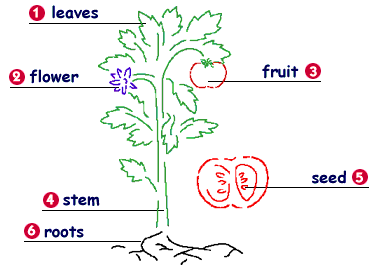 The roots help provide support by anchoring the plant and absorbing water and nutrients needed for growth. They can also store sugars and carbohydrates the plant uses to carry out other functions.
The roots help provide support by anchoring the plant and absorbing water and nutrients needed for growth. They can also store sugars and carbohydrates the plant uses to carry out other functions.
Stems carry water and nutrients taken up by the roots to the leaves, and then the food produced by the leaves moves to other parts of the plant. Stems also provide support for the plant allowing the leaves to reach the sunlight they need to produce food.
Leaves are the food making factories of green plants. Leaves come in many different shapes and sizes. Leaves are made to catch light and have openings to allow water and air to come and go. The outer surface of the leaf has a waxy coating called a cuticle which protects the leaf. Veins carry water and nutrients within the leaf. Leaves are the site of the food making process called photosynthesis.
Flowers not only look pretty but, in fact, are important in making of seeds. Fertilization takes place in the flower part of the plant. The parts of a flower are the pistil, which is female, the stamen, which is male, the receptacle, the sepal and the petal.
 During the process of fertilization, pollen lands on the stigma, a tube grows down the style and enters the ovary. Male sperm cells travel down the tube and join with the ovule, fertilizing it. The fertilized ovule becomes the seed, and the ovary becomes the fruit. Sepals are tiny green leaf-like parts located at the base of the flower. They help to protect the developing bud. Petals are also important parts of the flower because they help attract pollinators such as bees, butterflies and bats.
During the process of fertilization, pollen lands on the stigma, a tube grows down the style and enters the ovary. Male sperm cells travel down the tube and join with the ovule, fertilizing it. The fertilized ovule becomes the seed, and the ovary becomes the fruit. Sepals are tiny green leaf-like parts located at the base of the flower. They help to protect the developing bud. Petals are also important parts of the flower because they help attract pollinators such as bees, butterflies and bats.
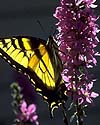 The fruit is the ripened ovary of a plant containing the seeds. After fertilization, the ovary swells and becomes either fleshy or hard and dry to protect the developing seeds. Many fruits help seeds spread (maple seeds). Many things we call vegetables are really fruits (tomato, cucumber, beans).
The fruit is the ripened ovary of a plant containing the seeds. After fertilization, the ovary swells and becomes either fleshy or hard and dry to protect the developing seeds. Many fruits help seeds spread (maple seeds). Many things we call vegetables are really fruits (tomato, cucumber, beans).
Seeds are a plant's way of getting from one area to another. Every seed is a tiny plant ( embryo) with leaves, stems, and root parts waiting for the right things to happen to make it germinate and grow. Seeds are protected by a coat. This coat can be thin or thick and hard. Thin coats don't protect the embryo well. But thick coats can let the embryo survive some tough conditions.
Plants are a great source of food. Here are some examples of the different parts of the plant that we eat.
Roots: Radishes, carrots, beets, turnips 
Seeds: Peas, lima beans, pinto beans 
Leaves: Lettuce, spinach, kale, cabbage 
Fruits: Apples, tomatoes, cucumbers, blueberries 
Flowers: Broccoli, cauliflower, squash 
Stems: Asparagus, celery, onions 
A plant's life cycle describes how long a plant lives or how long it takes to grow, flower, and set seed. Plants are one of three types; annuals, biennials and perennials.
Annuals are plants that grow, make flowers, fruit and seeds, and die all in one growing season. Here are a few examples of annuals.
 Pansies
Pansies
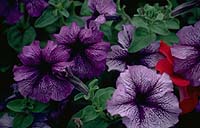 Petunias
Petunias
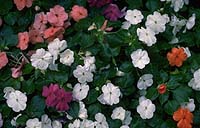 Impatiens
Impatiens
Biennials are plants that produce green leaves one year, flowers the next, and then die. Here are some examples of biennials.
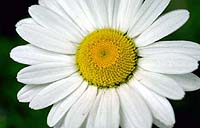 Shasta Daisy
Shasta Daisy
 Foxglove
Foxglove
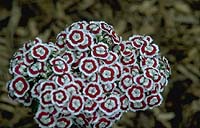 Sweet William
Sweet William
Perennials are plants that come back year after year without replanting. These plants are all perennials.
 Rose
Rose
 Peony
Peony
 Day Lily
Day Lily
There are seven basic requirements that plants need in order to grow properly. They are temperature, light, water, air, nutrients, time and room to grow. The three most important nutrients are nitrogen, phosphorus and potassium. Soil is also important because it holds the roots, stores nutrients and provides support for the plant.
Thank you for taking my class on plants. I hope that you found it enjoyable as well as educational.
Time for the exam.
| |
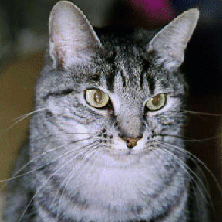


Pansies
Petunias
Impatiens
Shasta Daisy
Foxglove
Sweet William
There are seven basic requirements that plants need in order to grow properly. They are temperature, light, water, air, nutrients, time and room to grow. The three most important nutrients are nitrogen, phosphorus and potassium. Soil is also important because it holds the roots, stores nutrients and provides support for the plant.Rose
Peony
Day Lily